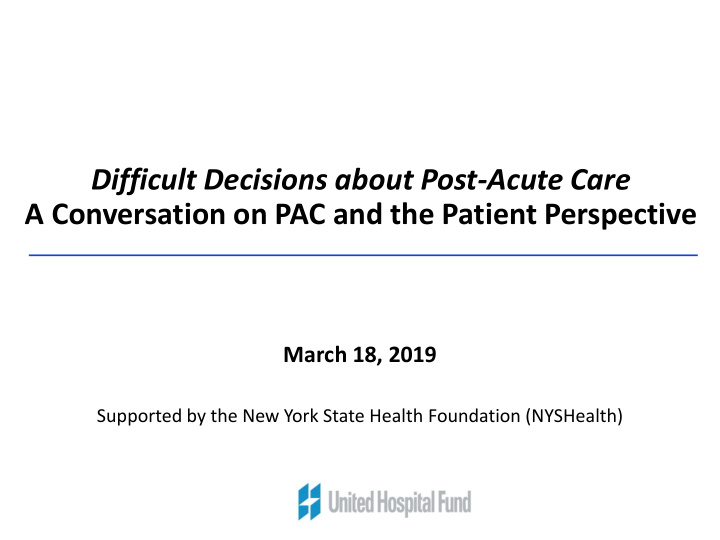



Difficult Decisions about Post-Acute Care A Conversation on PAC and the Patient Perspective March 18, 2019 Supported by the New York State Health Foundation (NYSHealth)
• To examine how decisions about post-acute care (PAC) are made during hospital discharge planning, especially when care in a SNF is needed • To better understand the complex factors that can influence those decisions , with a special focus on communication and information Project Aims sharing among providers, patients, and families • To identify opportunities and strategies for improving communication, practices, and policies that could better support more informed decision-making 2
What Is PAC Skilled nursing/rehab services delivered by 4 types of providers: • Skilled Nursing Facilities (SNFs) • Home Health Agencies (HHAs) • Inpatient Rehabilitation Facilities (IRFs) • Long-Term Care Hospitals (LTCHs) 3
Methods Information Scan – reviewed literature, regulatory framework, quality measures on websites, innovative tools, best practices for filling gaps in decision support Expert Interviews (27) – with researchers, advisors, stakeholders, policymakers, innovators, and others Patient and Family Caregiver Discussion Groups and Interviews – with 17 people who had experienced discharge planning for PAC in a SNF Meetings with leaders and frontline staff involved in discharge planning for PAC - 8 hospitals in the NY metro area; phone interviews with administrators at 5 SNFs in the NY metro area 4
Why Decisions about PAC Should Matter to Patients • Quality varies among PAC providers. Patients who receive care from lower quality providers have higher risk of complications and worse outcomes , contributing to rising costs, including out- of-pocket costs . • Choosing carefully can mean the difference between full recovery, cycling in and out of facilities, becoming a nursing home resident, or early death. 5
Demand for PAC is growing, but many factors can constrain a patient’s choice of setting and provider. Yet, patients and Other Key families are often unaware of what those constraints are. Findings Decision-making can pose daunting challenges for patients and Relevant to families. Yet hospital staff involvement varies and can fall short due to unintended consequences of regulation. Patients and Families Discharge planning is complex and time-sensitive. Hospital staff, patients, families feel pressure to reach decisions rapidly. Opportunities for key steps or information to slip lead to communication gaps. Public information has limits, not especially helpful for trying to figure out the best option. Provider lists commonly distributed by hospital discharge planners comply with regulations, but are insufficient. Existing legal safeguards don’t go far enough to support informed decision-making during hospital discharge planning. 6
Common Research Strategies for Patients and Families Choosing PAC • Some did little to no research, waiting for guidance Wait for it from hospital staff that they typically didn’t get Major Research • Some made a full scale project of visiting facilities, Project combing websites, and consulting friends (with reinforcements) • Asked their health professional friends (RNs, MDs, PTs, etc.) for recommendations, to investigate Know a Professional options, and help make choices. Some brought friends who were former staff on their visits to SNFs • Many relied on WOM recommendations, but Word of Mouth sometimes found them to be unreliable due to outdated expectations of care (e.g. LOS, staffing (WOM) levels, health plan participation)
Language • Online info and reviews often only in English Computer Literacy • Many relied on younger family members or friends to help with research and to translate information, Information citing language and computer literacy barriers Marketing v. Information Barriers for • Websites were largely promotional and lacked Patients and specifics on services, activities, staffing Families Understanding Quality Measures Choosing PAC • Some patients and families who did use websites like Nursing Home Compare found quality ratings unhelpful because they didn’t seem relevant to short-term stays Timeliness • Consumer review sites like Yelp, Facebook, Google user-reviews, were seen as helpful because they described people’s real, recent experiences
Location Convenient for family/friends Some willing to go further for specific services Intensity and Availability of Services What’s Frequency of physical therapy Important to Special services available? e.g. ventilator, Patients and specific disease supports (e.g. ALS), on-site dialysis Caregivers Ongoing Care when For patients who won’t be able to go home, Choosing a Is the PAC setting appropriate for transition to PAC Setting? long- term care? Finances Is the PAC facility in- network? Will the facility take patients with expensive medication needs?
Patients and Families in Discharge Planning Engage for PAC The Discharge Planning Process Improve Bridge To Create the Conditions for Informed Silos Decision-Making Six P Pathways to P Progr gres ess Address Regulatory and Payment Policy Barriers Enhance Public Information and Transparency Increase Public and Professional Awareness 10
1. Difficult Decisions About Post-Acute Care and Why They Matter 2. The Illusion of Choice: Why Decisions About Post-Acute Care Are Difficult for Patients and Family Caregivers UHF D Difficult 3. Health Care Provider Perspectives on Discharge Planning: From Hospital to Decisions Deci ns Skilled Nursing Facility Report t Series es 4. Pathways to Progress on Difficult Decisions in Post-Acute Care Free downloads available at https://uhfnyc.org/initiatives/post-acute-care/
Sharrie McIntosh, Laura Eldon, Jannel Tillman, and • New York State Health Foundation Today’s Conversation Participants and Audience • 12
Recommend
More recommend